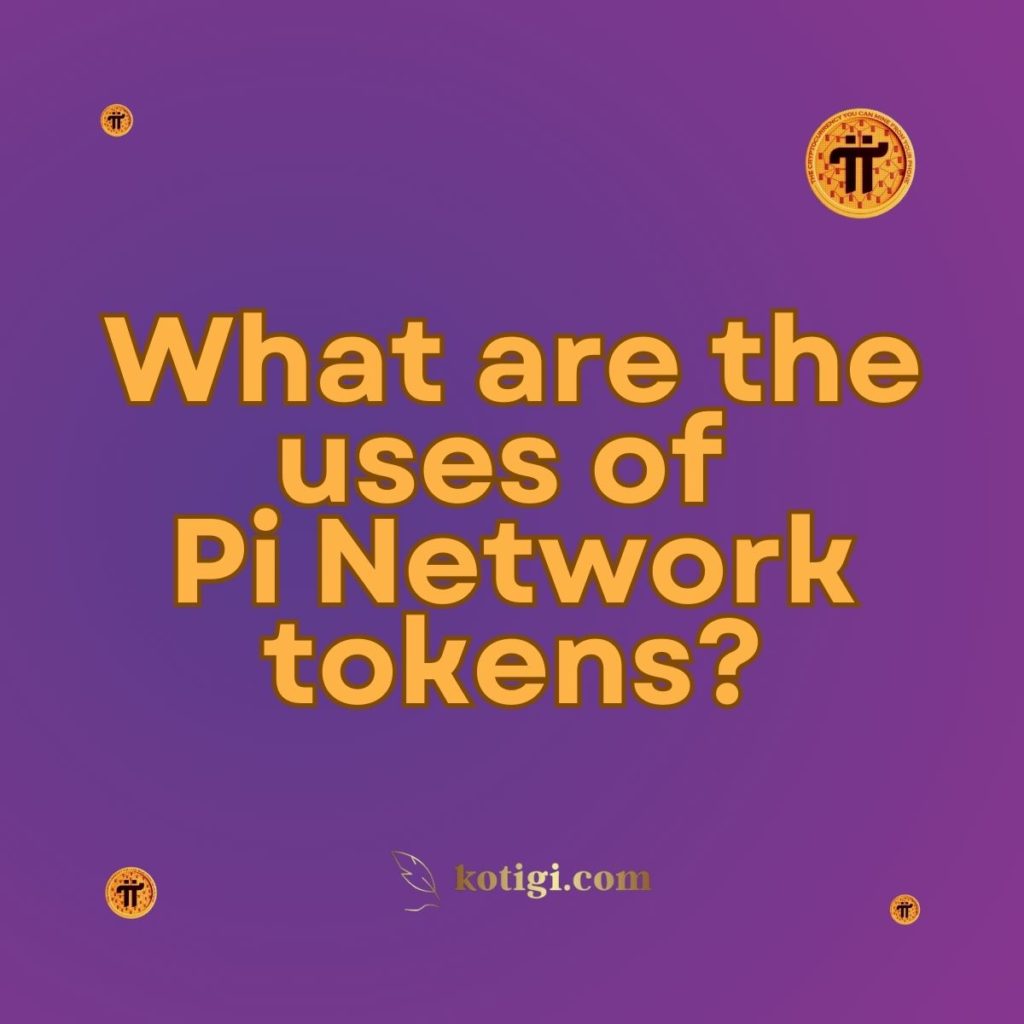
What are the uses of Pi Network tokens?
Pi Network tokens, known as Pi coins, can be used for various purposes, including transactions, accessing services within the Pi Ecosystem, staking, and participating in community governance, making them versatile assets in the evolving cryptocurrency landscape.
Introduction
In the rapidly evolving world of cryptocurrency, new projects continually emerge, each aiming to redefine how we perceive and utilize digital assets. One such project is the Pi Network, a unique platform designed to enable users to mine, manage, and utilize cryptocurrency in an accessible way. At the core of this ecosystem are the Pi tokens, often referred to as Pi coins, which serve multiple functions within the network.
Understanding the various uses of Pi Network tokens is essential for users looking to engage with the platform effectively. From facilitating transactions to enabling access to various services and features, Pi coins are versatile assets that hold significant potential in the cryptocurrency landscape. In this blog post, we will explore the different uses of Pi Network tokens, examining how they can benefit users and contribute to the overall growth of the network.
1. Transactions
Facilitating Peer-to-Peer Transactions
One of the primary uses of Pi Network tokens is to facilitate peer-to-peer transactions within the Pi community. Users can send and receive Pi coins directly to and from one another, enabling smooth and secure transactions without the need for intermediaries. This feature is particularly valuable for individuals looking to exchange goods and services or settle debts in a decentralized manner.
By utilizing Pi coins for everyday transactions, users can engage with the cryptocurrency in a practical and meaningful way. This fosters a sense of community among users and encourages broader adoption of Pi as a viable digital currency.
Merchant Transactions
As the Pi Network continues to grow, an increasing number of merchants and service providers are beginning to accept Pi tokens as a form of payment. This development opens new avenues for users, allowing them to spend their earned Pi coins on goods and services in the real world.
By establishing partnerships with merchants, the Pi Network enhances the utility of Pi tokens, making them more valuable to users. The growing acceptance of Pi coins as a payment method signifies the platform’s potential to become a recognized currency in the digital economy.
Reducing Transaction Costs
Traditional financial systems often involve high fees for processing transactions, particularly in cross-border payments. In contrast, transactions conducted using Pi Network tokens can significantly reduce these costs. Since the Pi Network operates on a decentralized model, users can transfer Pi coins without incurring substantial fees, making it an attractive option for both individuals and businesses.
This cost-effectiveness is essential for promoting widespread adoption, especially in regions where access to traditional banking services is limited. By providing a low-cost alternative for transactions, Pi Network tokens can empower users globally.
2. Accessing Services within the Pi Ecosystem
Utilizing DApps and Services
The Pi Network is not just a cryptocurrency; it is an entire ecosystem of decentralized applications (dApps) and services. Users can leverage their Pi tokens to access various functionalities within this ecosystem, including games, marketplaces, and financial services.
By using Pi coins to engage with dApps, users can enhance their experience and unlock new opportunities for interaction and growth. The versatility of Pi tokens allows them to serve as a key to a broad range of services that cater to the diverse needs of the community.
Staking and Earning Rewards
Staking is another significant use of Pi Network tokens within its ecosystem. Users can stake their Pi coins to support network operations and governance while earning rewards in return. This mechanism not only incentivizes participation but also enhances the security and stability of the network.
Through staking, users can contribute to the overall health of the Pi Network while generating passive income. This dual benefit makes staking an attractive option for users looking to maximize their holdings and support the platform’s growth.
Accessing Exclusive Features
Many applications and services within the Pi Network offer exclusive features that can only be accessed using Pi tokens. For instance, certain dApps may require users to pay a small fee in Pi coins to unlock premium content or advanced functionalities.
This creates an additional incentive for users to acquire and utilize Pi tokens actively. As the ecosystem grows and more services are introduced, the demand for Pi coins is likely to increase, further enhancing their utility.
3. Participating in Governance
Community Governance
The Pi Network operates on a community-driven model, empowering users to have a voice in the platform’s future. Pi token holders can participate in governance decisions, allowing them to influence key aspects of the network’s development and direction.
By holding and using Pi tokens, users can vote on proposals, feature enhancements, and other critical decisions that shape the ecosystem. This democratic approach fosters a sense of ownership among users, encouraging them to take an active role in the community.
Proposal Voting
One of the main avenues for governance participation is proposal voting. Pi token holders can submit proposals for changes or improvements to the network, which are then put to a vote among the community. This process ensures that decisions are made collectively, reflecting the interests and preferences of the user base.
By allowing users to engage in governance through their tokens, the Pi Network cultivates a collaborative environment where everyone’s voice matters. This commitment to inclusivity strengthens the community and reinforces the network’s decentralized nature.
Accountability and Transparency
The governance model of the Pi Network is built on principles of accountability and transparency. Users can track the progress of proposals, view voting results, and understand how decisions are made within the network. This openness builds trust among users, as they can see how their input influences the platform’s direction.
By fostering an accountable governance structure, the Pi Network enhances user engagement and loyalty, further solidifying its position in the cryptocurrency landscape.
4. Staking and Earning Passive Income
Understanding Staking
Staking is a process through which users lock up their Pi tokens to support network operations while earning rewards. This mechanism is vital for maintaining the integrity and security of the Pi Network, as it incentivizes users to contribute to its growth.
Users can stake their Pi coins for a specified period, during which they are not able to access them. In return, they receive rewards in the form of additional Pi tokens, which can enhance their holdings over time. This process aligns user interests with the network’s health, creating a mutually beneficial relationship.
Benefits of Staking
Staking offers several benefits for Pi token holders. Firstly, it provides an opportunity to earn passive income without actively trading or investing in external markets. This feature is particularly appealing for users who wish to grow their holdings steadily over time.
Moreover, staking contributes to the overall security of the Pi Network. By locking up their tokens, users help prevent malicious actors from attacking the network, ensuring its continued stability and reliability.
Choosing the Right Staking Strategy
When it comes to staking Pi tokens, users should consider various strategies based on their individual goals and risk tolerance. Factors such as the duration of staking, the potential rewards, and the overall market conditions should be taken into account.
Users may choose to stake for short or long periods, depending on their financial objectives. By selecting a strategy that aligns with their goals, users can maximize their staking benefits and contribute effectively to the Pi Network.
5. Promoting Pi Network Growth
Incentivizing New Users
The use of Pi Network tokens plays a crucial role in promoting the platform’s growth and attracting new users. Through referral programs and community initiatives, existing users are encouraged to invite others to join the network, creating a cycle of expansion.
When new users join and engage with the network, they contribute to the overall activity and vitality of the platform. This, in turn, increases the demand for Pi tokens, enhancing their value and utility.
Expanding Use Cases
As the Pi Network evolves, the potential use cases for Pi tokens continue to expand. Developers and entrepreneurs within the ecosystem are encouraged to create new applications and services that utilize Pi coins, increasing their relevance in various markets.
By fostering an environment where innovation thrives, the Pi Network positions itself as a forward-thinking platform that adapts to the changing needs of its community. This adaptability is essential for long-term success in the dynamic cryptocurrency landscape.
Building Strategic Partnerships
The Pi Network actively seeks to build strategic partnerships with other platforms and businesses to enhance the utility of its tokens. Collaborations can lead to new opportunities for Pi token holders, such as discounts, rewards, or exclusive access to products and services.
These partnerships not only benefit users but also contribute to the overall ecosystem’s growth, creating a win-win situation for all stakeholders involved.
6. The Future of Pi Tokens
Roadmap and Development Plans
The future of Pi Network tokens is intertwined with the platform’s roadmap and development plans. As the network progresses toward its mainnet launch and beyond, the potential use cases for Pi coins will continue to evolve.
Developers and the Pi Core Team are focused on enhancing the functionality of the network, introducing new features, and expanding the ecosystem to meet the demands of users. This commitment to continuous improvement is vital for maintaining user interest and engagement.
Adoption Trends
As awareness of the Pi Network increases and more users engage with the platform, the adoption of Pi tokens is likely to rise. Increased acceptance among merchants, service providers, and users will solidify the position of Pi coins as a legitimate digital currency.
The trend of broader adoption will create a positive feedback loop, where increased usage leads to higher demand, ultimately driving up the value of Pi tokens. This potential for appreciation adds an exciting dimension to holding and utilizing Pi coins.
Community-driven Growth
The Pi Network thrives on community-driven growth, with users actively participating in shaping the platform’s future. As more individuals join and contribute, the ecosystem will continue to expand and innovate.
User feedback, engagement, and collaboration will be essential for guiding the direction of the network. The Pi Network’s commitment to inclusivity and transparency ensures that the voices of its users are heard and valued.
Conclusion:
In summary, Pi Network tokens are versatile assets with a wide range of uses within the platform. From facilitating transactions and accessing services to participating in governance and staking, these tokens play a crucial role in the overall functionality of the Pi Network.
As the platform continues to grow and evolve, the potential uses for Pi coins will expand, offering users more opportunities to engage with the ecosystem. By fostering a strong sense of community and promoting user participation, the Pi Network is well-positioned for long-term success in the dynamic world of cryptocurrency.
As users explore the various uses of Pi Network tokens, they can look forward to being part of a thriving community that embraces innovation and collaboration, paving the way for a brighter digital future.
Key Takeaways:
- Pi Network tokens (Pi coins) are used for peer-to-peer transactions, allowing users to send and receive payments easily.
- Users can access various services and features within the Pi Ecosystem by utilizing Pi tokens, enhancing their experience.
- Staking Pi tokens provides users with the opportunity to earn passive income while supporting the network’s security.
- Participation in governance decisions allows users to influence the future direction of the Pi Network through their tokens.
- The growth of Pi Network tokens is driven by community engagement, partnerships, and the development of new use cases.





